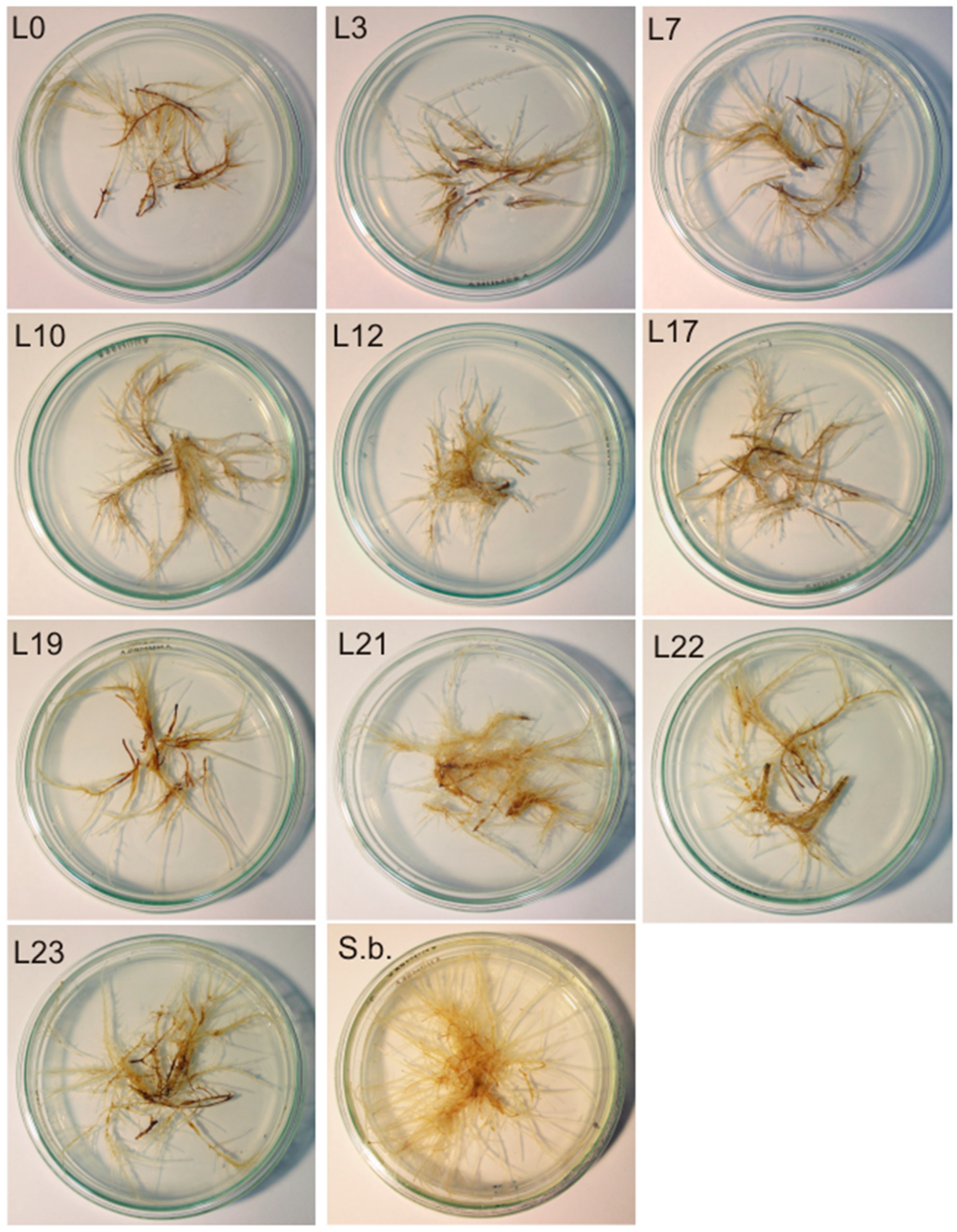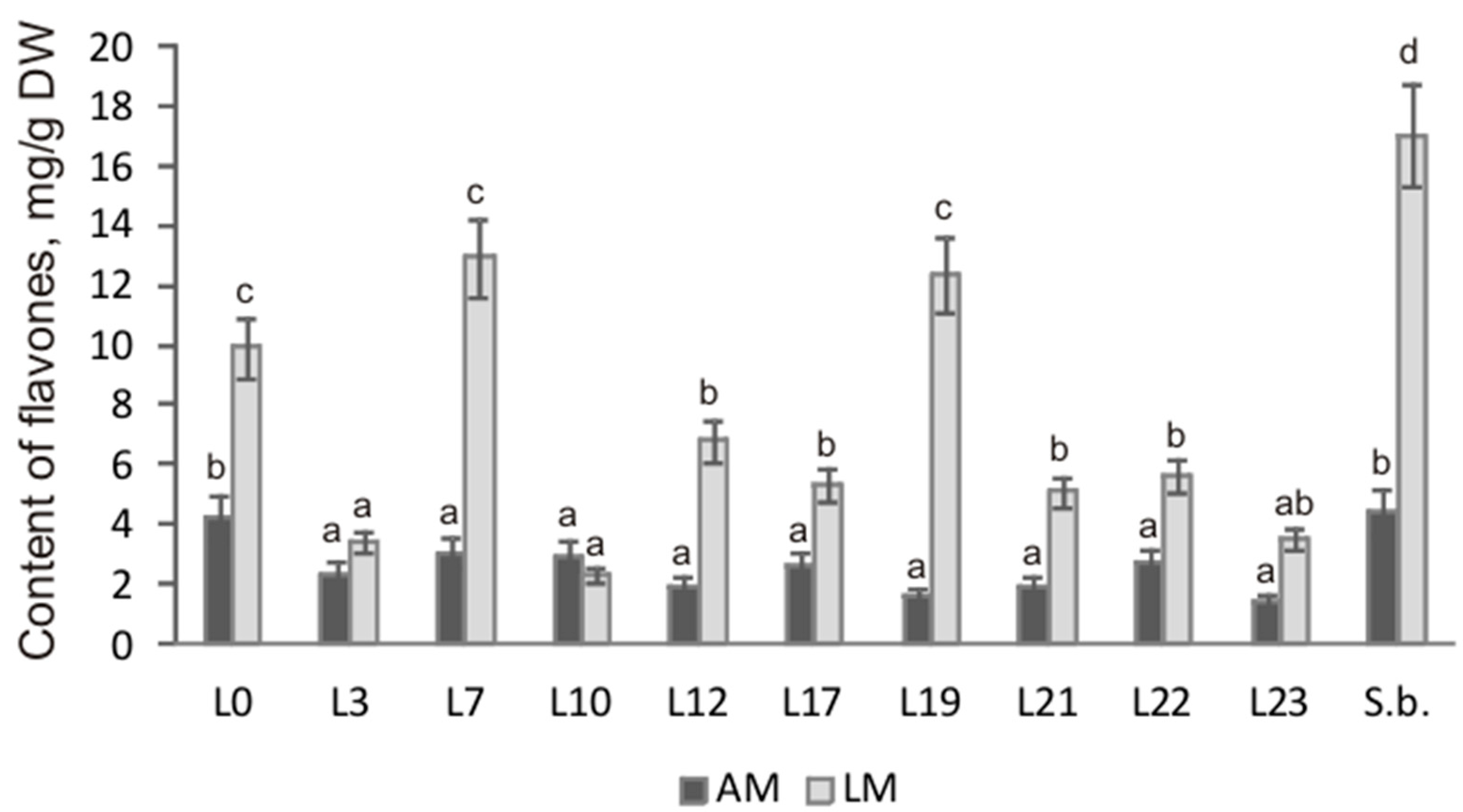Metabolic Characteristics of Hairy Root Clones of Scutellaria pycnoclada and Scutellaria baicalensis
Abstract
:1. Introduction
2. Materials and Methods
2.1. Establishment of S. pycnoclada Transformed Root Cultures
2.2. PCR Analysis
2.3. HPLC-UV Analysis
2.4. HPLC-MS/MS Analysis
2.5. Statistical Analysis
3. Results and Discussion
3.1. Establishment of Hairy Root Lines of S. pycnoclada
3.2. The Presence of Different Genes of TL- and TR-DNA in Hairy Roots Clones of S. baicalensis and S. pycnoclada
3.3. The Qualitative Composition of Flavones
3.4. Content of the Main Flavones
4. Conclusions
Supplementary Materials
Author Contributions
Funding
Data Availability Statement
Acknowledgments
Conflicts of Interest
References
- Shah, M.; Mubin, S.; Hassan, S.S.U.; Tagde, P.; Ullah, O.; Rahman, M.H.; Al-Harrasi, A.; Rehman, N.U.; Murad, W. Phytochemical profiling and bio-potentiality of genus Scutellaria: Biomedical approach. Biomolecules 2022, 12, 936. [Google Scholar] [CrossRef] [PubMed]
- Zhao, T.; Tang, H.; Xie, L.; Zheng, Y.; Ma, Z.; Sun, Q.; Li, X. Scutellaria baicalensis Georgi. (Lamiaceae): A review of its traditional uses, botany, phytochemistry, pharmacology and toxicology. J. Pharm. Pharmacol. 2019, 71, 1353–1369. [Google Scholar] [CrossRef] [PubMed] [Green Version]
- Zhao, Q.; Zhang, Y.; Wang, G.; Hill, L.; Weng, J.K.; Chen, X.Y.; Xue, H.; Martin, C. A specialized flavone biosynthetic pathway has evolved in the medicinal plant, Scutellaria baicalensis. Sci. Adv. 2016, 2, e1501780. [Google Scholar] [CrossRef]
- Malikov, V.M.; Yuldashev, M.P. Phenolic compounds of plants of the Scutellaria genus. distribution, structure, and properties. Chem. Nat. Compd. 2002, 38, 473–519. [Google Scholar] [CrossRef]
- Kovács, G.; Kuzovkina, I.; Szoke, É.; Kursinszki, L. HPLC determination of flavonoids in hairy-root cultures of Scutellaria baicalensis Georgi. Chromatographia 2004, 60, 81–85. [Google Scholar] [CrossRef]
- Tiwari, R.K.; Trivedi, M.; Guang, Z.C.; Guo, G.Q.; Zheng, G.C. Agrobacterium rhizogenes mediated transformation of Scutellaria baicalensis and production of flavonoids in hairy roots. Biol. Plant. 2008, 52, 26–35. [Google Scholar] [CrossRef]
- Wilczańska-Barska, A.; Królicka, A.; Głód, D.; Majdan, M.; Kawiak, A.; Krauze-Baranowska, M. Enhanced accumulation of secondary metabolites in hairy root cultures of Scutellaria lateriflora following elicitation. Biotechnol. Lett. 2012, 34, 1757–1763. [Google Scholar] [CrossRef]
- Wysokinska, H.; Chmiel, A. Transformed root cultures for biotechnology. Acta Biotechnol. 1997, 17, 131–159. [Google Scholar] [CrossRef]
- Abhyankar, G.; Rao, K.V.; Reddy, V.D. Genomic and metabolomic fingerprinting of Phyllanthus amarus (Schumm & Thonn) hairy root clones. Ann. Phytomed. 2013, 2, 74–88. [Google Scholar]
- Nishikawa, K.; Ishimaru, K. Flavonoids in root cultures of Scutellaria baicalensis. J. Plant Physiol. 1997, 151, 633–636. [Google Scholar] [CrossRef]
- Stepanova, A.Y.; Solov’eva, A.I.; Malunova, M.V.; Salamaikina, S.A.; Panov, Y.M.; Lelishentsev, A.A. Hairy roots of Scutellaria spp. (Lamiaceae) as promising producers of antiviral flavones. Molecules 2021, 26, 3927. [Google Scholar] [CrossRef]
- Amselem, J.; Tepfer, M. Molecular basis for novel root phenotypes induced by Agrobacterium rhizogenes A4 on cucumber. Plant Mol. Biol. 1992, 19, 421–432. [Google Scholar] [CrossRef] [PubMed]
- Kawka, B.; Kwiecień, I.; Ekiert, H. Endogenous production of specific flavonoids and verbascoside in agar and agitated microshoot cultures of Scutellaria lateriflora L. and biotransformation potential. Plant Cell Tissue Organ Cult. 2020, 142, 471–482. [Google Scholar] [CrossRef]
- Nunes, C.F.; Ferreira, J.L.; Nunes-Fernandes, M.C.; de Souza Breves, S.; Generoso, A.L.; Fontes-Soares, B.D.; Carvalho-Dias, M.S.; Pasqual, M.; Borem, A.; de Almeida Cancado, G.M. An improved method for genomic DNA extraction from strawberry leaves. Ciênc. Rural 2011, 41, 1383–1389. [Google Scholar] [CrossRef] [Green Version]
- Li, F.X.; Jin, Z.P.; Zhao, D.X.; Cheng, L.Q.; Fu, C.X.; Ma, F. Overexpression of the Saussurea medusa chalcone isomerase gene in S. involucrata hairy root cultures enhances their biosynthesis of apigenin. Phytochemistry 2006, 67, 553–560. [Google Scholar] [CrossRef]
- Kim, J.K.; Kim, Y.S.; Kim, Y.; Uddin, M.R.; Kim, Y.B.; Kim, H.H.; Park, S.Y.; Lee, M.Y.; Chung, S.O.; Park, S.U. Comparative analysis of flavonoids and polar metabolites from hairy roots of Scutellaria baicalensis and Scutellaria lateriflora. World J. Microbiol. Biotechnol. 2014, 30, 887–892. [Google Scholar] [CrossRef]
- Gharari, Z.; Bagheri, K.; Danafar, H.; Sharafi, A. Enhanced flavonoid production in hairy root cultures of Scutellaria bornmuelleri by elicitor induced over-expression of MYB7 and FNS∏2 genes. Plant Physiol. Biochem. 2020, 148, 35–44. [Google Scholar] [CrossRef]
- Jouanin, L.; Guerche, P.; Pamboukdjian, N.; Tourneur, C.; Casse Delbart, F.; Tourneur, J. Structure of T-DNA in plants regenerated from roots transformed by Agrobacterium rhizogenes strain A4. Mol. Gen. Genet. 1987, 206, 387–392. [Google Scholar] [CrossRef]
- Alpizar, E.; Dechamp, E.; Lapeyre-Montes, F.; Guilhaumon, C.; Bertrand, B.; Jourdan, C.; Lashermes, P.; Etienne, H. Agrobacterium rhizogenes-transformed roots of coffee (Coffea arabica): Conditions for long-term proliferation, and morphological and molecular characterization. Ann. Bot. 2008, 101, 929–940. [Google Scholar] [CrossRef] [Green Version]
- Taneja, J.; Jaggi, M.; Wankhede, D.P.; Sinha, A.K. Effect of loss of T-DNA genes on MIA biosynthetic pathway gene regulation and alkaloid accumulation in Catharanthus roseus hairy roots. Plant Cell Rep. 2010, 29, 1119–1129. [Google Scholar] [CrossRef]
- Xu, Z.; Gao, R.; Pu, X.; Xu, R.; Wang, J.; Zheng, S.; Zeng, Y.; Chen, J.; He, C.; Song, J. Comparative genome analysis of Scutellaria baicalensis and Scutellaria barbata reveals the evolution of active flavonoid biosynthesis. Genom. Proteom. Bioinform. 2020, 18, 230–240. [Google Scholar] [CrossRef] [PubMed]
- Zhao, Q.; Yang, J.; Cui, M.Y.; Liu, J.; Fang, Y.; Yan, M.; Qiu, W.; Shang, H.; Xu, Z.; Yidiresi, R.; et al. The reference genome sequence of Scutellaria baicalensis provides insights into the evolution of wogonin biosynthesis. Mol Plant. 2019, 12, 935–950. [Google Scholar] [CrossRef] [PubMed] [Green Version]
- Cui, M.Y.; Lu, A.R.; Li, J.X.; Liu, J.; Fang, Y.M.; Pei, T.L.; Zhong, X.; Wi, Y.K.; Kong, Y.; Qiu, W.Q.; et al. Two types of O-methyltransferase are involved in biosynthesis of anticancer methoxylated 4’-deoxyflavones in Scutellaria baicalensis Georgi. Plant Biotechnol. J. 2022, 20, 129–142. [Google Scholar] [CrossRef]
- Pei, T.; Yan, M.; Li, T.; Li, X.; Yin, Y.; Cui, M.; Fang, Y.; Liu, J.; Kong, Y.; Xu, P.; et al. Characterization of UDP-glycosyltransferase family members reveals how major flavonoid glycoside accumulates in the roots of Scutellaria baicalensis. BMC Genom. 2022, 23, 169. [Google Scholar] [CrossRef] [PubMed]
- Grzegorczyk-Karolak, I.; Kuźma, Ł.; Wysokińska, H. In vitro cultures of Scutellaria alpine as a source of pharmacologically active metabolites. Acta Physiol. Plant. 2016, 38, 7. [Google Scholar] [CrossRef] [Green Version]
- Solov’eva, A.I.; Evsyukov, S.V.; Sidorov, R.A.; Stepanova, A.Y. Correlation of endogenous β-glucuronidase activity with differentiation of in vitro cultures of Scutellaria baicalensis. Acta Physiol. Plant. 2020, 42, 169. [Google Scholar] [CrossRef]
- Kuzovkina, I.N.; Prokof’eva, M.Y.; Umralina, A.R.; Chernysheva, T.P. Morphological and biochemical characteristics of genetically transformed roots of Scutellaria andrachnoides. Russ. J. Plant Physiol. 2014, 61, 697–706. [Google Scholar] [CrossRef]
- Ikegami, F.; Matsunae, K.; Hisamitsu, M.; Kurihara, T.; Yamamoto, T.; Murakoshi, I. Purifcation and properties of a plant b-D-glucuronidase form Scutellaria root. Biol. Pharm. Bull. 1995, 18, 1531–1534. [Google Scholar] [CrossRef] [Green Version]
- Morimoto, S.; Tateishi, N.; Matsuda, T.; Tanaka, H.; Taura, F.; Furuya, N.; Matsuyama, N.; Shoyama, Y. Novel hydrogen peroxide metabolism in suspension cells of Scutellaria baicalensis Georgi. J. Biol. Chem. 1998, 273, 12606–12611. [Google Scholar] [CrossRef] [Green Version]
- Zhang, C.; Zhang, Y.; Chen, J.; Liang, X. Purifcation and characterization of baicalin-b-D-glucuronidase hydrolyzing baicalin to baicalein from fresh roots of Scutellaria viscidula Bge. Process. Biochem. 2005, 40, 1911–1915. [Google Scholar] [CrossRef]






| Genes | Nucleotide Sequence (nt) | Tm (°C) |
|---|---|---|
| rolA | 5′-CAGAATGGAATTAGCCGGACTA-3′ | 62 |
| 5′-TTAATCCCGTAGGTTTGTTTCG-3′ | ||
| rolB | 5′-GCTCTTGCAGTGCTAGATTT-3′ | 60 |
| 5′-GAAGGTGCAAGCTACCTCTC-3′ | ||
| rolC | 5′-ATGGCTGAAGACGACCTGTGT-3′ | 54 |
| 5′-GCCGATTGCAAACTTGCACTC-3′ | ||
| rolD | 5′-CATCTGCAACTGAGCGTGTG-3′ | 62 |
| 5′-TGTCTGATAGGGAGGAACGA-3′ | ||
| aux2 | 5′-GTCTATTGCTTCTTCTATCG-3′ | 54 |
| 5′-GTCTCAGGGAAAGAAAATAC-3′ | ||
| virD | 5′-ATGTCGCAAGGCAGTAAGCCC-3′ | 66 |
| 5′-GGAGTCTTTCAGCATGGAGCAA-3′ |
| № | Compound | Molecular Mass | MRM-Transition, m/z |
|---|---|---|---|
| 1 | chrysin | 254 | 255.1 → 153.1 |
| 2 | baicalein | 270 | 271.1 → 123.1 |
| 3 | apigenin | 270 | 271.1 → 153.1 |
| 4 | naringenin | 272 | 273.1 → 153.1 |
| 5 | oroxylin A | 284 | 285.1 → 267.1 |
| 6 | wogonin | 284 | 285.1 → 270.1 |
| 7 | tenaxin I | 344 | 345.1 → 330.1 |
| 8 | scullcapflavone II | 374 | 375.1 → 345.1 |
| 9 | chrysin-6-C-β-d-glucoside * chrysin-8-C-β-d-glucoside * | 416 | 417.1 → 281.1 |
| 10 | chrysin-7-O-β-d-glucuronide | 430 | 431.1 → 255.1 |
| 11 | apigetrin (apigenin-7-O-β-d-glucoside) | 432 | 433.1 → 271.1 |
| 12 | oroxin A (baicalein-7-O-β-d-glucoside) | 432 | 433.1 → 415.1 |
| 13 | baicalin | 446 | 447.1 → 271.1 |
| 14 | wogonoside | 460 | 461.1 → 285.1 |
| 15 | scutellarin | 462 | 463.1 → 287.1 |
| 16 | isocarthamidin-7-O-β-d-glucuronide * carthamidin-7-O-β-d-glucuronide * | 464 | 465.1 → 289.1 |
| 17 | viscidulin III 6-O-β-d-glucoside | 508 | 509.1 → 347.1 |
| Line | Flavonoid | |
|---|---|---|
| Liquid Medium | Agar Medium | |
| L0 | 1–3, 6, 7, 9–17 | 1–3, 6, 9–17 |
| L3 | 1–3, 6, 7, 9–17 | 1–3, 6, 9–17 |
| L7 | 1–3, 6, 7, 9–17 | 1–3, 6, 9–17 |
| L10 | 1–3, 6, 7, 9–17 | 1–3, 6, 9–13, 14 *,15–17 |
| L12 | 1–3, 6, 7, 9–17 | 1–3, 6, 9–17 |
| L17 | 1–3, 6, 7, 9–17 | 1–3, 6, 9–17 |
| L19 | 1–3, 6, 7, 9–17 | 1–3, 6, 9–17 |
| L21 | 1–3, 6, 7, 9–17 | 1–3, 6, 9–17 |
| L22 | 1–3, 6, 7, 9–17 | 1–3, 6, 9–17 |
| L23 | 1–3, 6, 7, 9–17 | 1–3, 6, 9–17 |
| S.b. | 1 *, 2–8, 10–17 | 1 *, 2–8, 10–17 |
Disclaimer/Publisher’s Note: The statements, opinions and data contained in all publications are solely those of the individual author(s) and contributor(s) and not of MDPI and/or the editor(s). MDPI and/or the editor(s) disclaim responsibility for any injury to people or property resulting from any ideas, methods, instructions or products referred to in the content. |
© 2023 by the authors. Licensee MDPI, Basel, Switzerland. This article is an open access article distributed under the terms and conditions of the Creative Commons Attribution (CC BY) license (https://creativecommons.org/licenses/by/4.0/).
Share and Cite
Solov’eva, A.I.; Stepanova, A.Y.; Panov, Y.M.; Gladkov, E.A. Metabolic Characteristics of Hairy Root Clones of Scutellaria pycnoclada and Scutellaria baicalensis. Processes 2023, 11, 2102. https://doi.org/10.3390/pr11072102
Solov’eva AI, Stepanova AY, Panov YM, Gladkov EA. Metabolic Characteristics of Hairy Root Clones of Scutellaria pycnoclada and Scutellaria baicalensis. Processes. 2023; 11(7):2102. https://doi.org/10.3390/pr11072102
Chicago/Turabian StyleSolov’eva, Aleksandra I., Anna Y. Stepanova, Yury M. Panov, and Evgeny A. Gladkov. 2023. "Metabolic Characteristics of Hairy Root Clones of Scutellaria pycnoclada and Scutellaria baicalensis" Processes 11, no. 7: 2102. https://doi.org/10.3390/pr11072102








